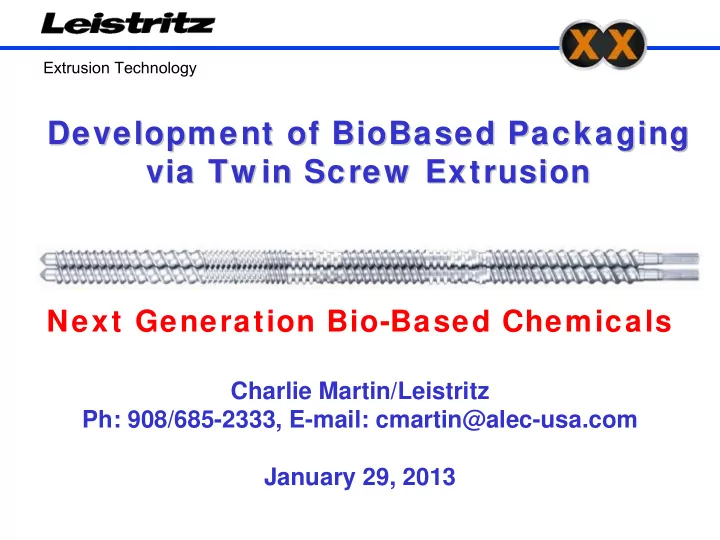

Extrusion Technology Development of BioBased Packaging Development of BioBased Packaging via Tw in Screw Extrusion via Tw in Screw Extrusion Next Generation Bio-Based Chemicals Charlie Martin/Leistritz Ph: 908/685-2333, E-mail: cmartin@alec-usa.com January 29, 2013
Tw in Screw Extrusion (TSE) Tw in Screw Extrusion (TSE) Process Sequence Process Sequence Pellets Powders/Fillers TSE Size & Finish • pellets then/or…. • feed cool • sheet/film • melt • air Liquids • tube/profile • mix • water • filament/fiber • devolatilize • rolls • adhesive coat • pump • conveyors • injection mold Fibers Processing PLA on TSE’s • Temperature sensitive • Moisture/melt = hydrolysis • Shear sensitive • Torque limited
HSEI TSE w / LIW Feeders HSEI TSE w / LIW Feeders • TSE’s are starve fed, feeders set the rate, screw rpm is independent • Keep PLA in sealed cartons before processing • Stainless steel metals for stagnant flow areas • Pay attention to shutdown/purging protocols • Heated water and other pelletizer mods to augment crystallization
Segmented TSE Process Section Segmented TSE Process Section Rotating screws impart shear and energy into materials being processed
Barrel Section Temperature Control Barrel Section Temperature Control
Cooling Schematic Barrel Cooling Schematic Barrel Inlet #1 Inlet #2 Quick disconnect Needle valve Coax valve
Co- -rotating TSE design rotating TSE design Co Solids conveying Melt & mix More mixing Convey Pump/discharge Vent Mix and seal
Modified shaft design Modified shaft design More splines and asymmetrical geometry
Smaller diameter shaft can transmit more torque
Test #1 Test #1 ZSE- -27 rate tests 27 rate tests ZSE PLA NatureWorks 2002D ZSE-27 HP ZSE-27 MAXX •27 mm screw dia. •28.3 mm screw dia. •4.5 mm flight depth •5.7 mm flight depth •10.3 cc/dia. free vol. •14.3 cc/dia. free vol. 40 to 1 L/D process section Screw s centerline = 23 mm 1280 screw s RPM 50 HP AC motor Same temperature profile
Screw designs: ZSE- -27 HP vs MAXX 27 HP vs MAXX Screw designs: ZSE ZSE-27 HP ZSE-27 MAXX Tests used open end discharge, less than 100 psi pressure
Process Comparison- ZSE 27 PLA- NatureWorks 2002D: what’s the residence time?
PLA- NatureWorks 2002D: 20, 10 & 5 seconds
ZSE-75 MAXX Underw ater pelletizer front-end RT for 800 kgs/hr = 4 seconds
ZSE-75 MAXX Sheet system front-end RT for 800 kgs/hr = 91 seconds
Temperature rise during pressure generation Temperature rise during pressure generation ∆ T (°C) = ∆ P (bar) / 2 (+/- 50%) • 40 Bar (580 PSI) Pressure results in a 20°C melt temperature rise (40/2) • Restrictive front-end designs may adversely effect the product • RPM, discharge screw elements & materials play a role in Tm Restrictive die Medium die restriction Less restrictive die
Gear Pump Front End Gear Pump Front End 300 bar pressure differential possible 200 bar 25 bar DISCHARGE: INLET: Anything TSE & that requires coarse pressure filtration generation (maybe)
Gear pump before screen changer & pelletizer Gear pump before screen changer & pelletizer
Direct Extrusion Process Sequence Direct Extrusion Process Sequence Pellets Powders/Fillers TSE Sheet/Profile/ Fiber Fibers • Eliminates heat/shear history (less MW loss) • Saves conversion cost associated w/ pelletization Liquids • Feeds high percentage of reclaim
Pressure profile in a TSE Pressure profile in a TSE Vent Pressurize die Feed PLA, Add filler or gear pump & additives dow nstream inlet after melting
Test #2 Test #2 Direct extrusion of PLA/filler > sheet Direct extrusion of PLA/filler > sheet • NatureWorks™ PLA 2003D w ith 15 & 25% CaC03 (Specialty Minerals EM Force™) • 2 Loss-in-w eight metering feeders • ZSE-27 MAXX, 1.66/1 OD/ID @ 40/1 L/D • Side stuffer @ barrel position #5; vent in #4 (atm.); #7 (atm.) and #9 (vacuum) • Gear pump and 250 mm w ide flex-lip die • 3-roll stack w ith puller and w inder
Summary Summary • Process developed @ 140 rpm • Zones: 170-190 deg. C • 20 kgs/hr @ 60% motor load • GP inlet pressure approx. 20 bar • Melt temperature 185 deg. C • Die gap @ 1 mm for ½ mm thick sheet • Result: dispersed product w/ good dimensional stability, seems like candidate for scale-up tests • Mechanicals: increased impact properties 10 -20 times compared to neat PLA (normalized Gardiner Impact MFE, 0.06 to 0.6 -1.14)
Impact Test Comparisons Impact Test Comparisons
Test #3 Test #3 Undried PLA test/run conditions Undried PLA test/run conditions • 1500 PPM moisture for PLA pellets and 2000 to 5000 PPM for sheet edge reclaim (50% pellets, 50% reclaim) • Process developed @ 250 rpm on ZSE-50 MAXX & 200 kgs/hr @ 70% motor load • Screw design for early atmospheric vent, 2 vacuum vents and minimal shear, Zones: 180-190 deg. C • GP inlet pressure: approx. 25 bar, Melt temp. 180 deg. C • 760 mm wide flex-lip sheet die and downstream roll stack • Result: MW loss in 5 to 10% range • Scale-up: volumetric scale to 4000 kgs/hr. on ZSE-140…2000+ kgs/hr more likely. Direct extrusion viable for this formulation.
Process Section for undried PLA Process Section for undried PLA Devol efficiencies = RT @ vents, size melt pool, surface renewal, vacuum level
Vacuum pump schematic Vacuum pump schematic
Molecular Weight – – dried vs. undried dried vs. undried Molecular Weight
Foam extrusion from TSE Foam extrusion from TSE additives PLA w/
Discharge element comparison Discharge element comparison
Extruder Cooling Screw Single Pump/
Davis- -Standard tandem foam system Standard tandem foam system Davis
Some questions before jumping… … Some questions before jumping • Pelletization or direct extrusion? • What are the critical boundary conditions? • What’s the method to heat/cool the barrels? • What’s the free volume? • What’s the torque rating? • What’s the TSE screw rpm and w hy? • Tw in screw extrusion systems don’t need to be redesigned, merely “tw eaked” for success New technologies are available for success
Recommend
More recommend